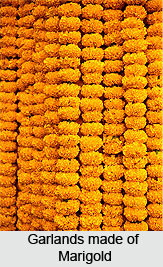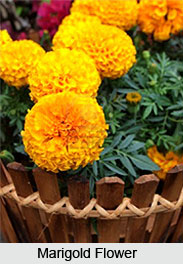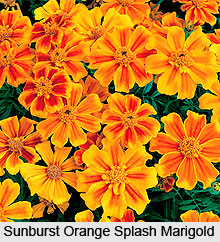 Marigolds, also known as Ganda, Holligold, Caltha, Marybud etc., belongs to the sunflower family and are easy to grow, blossom reliably all summer and have few insect and disease problems. They have understandably been the favourite perennial plant for many years. Marigolds enhance the look of gardens due to their bold and bright colours and resiliency. Marigolds comprises of two broad genuses, namely Celandula and Tagetes. Pot Marigolds are included in Celandula where as French Marigolds and African Marigolds are included in Tagetes.
Marigolds, also known as Ganda, Holligold, Caltha, Marybud etc., belongs to the sunflower family and are easy to grow, blossom reliably all summer and have few insect and disease problems. They have understandably been the favourite perennial plant for many years. Marigolds enhance the look of gardens due to their bold and bright colours and resiliency. Marigolds comprises of two broad genuses, namely Celandula and Tagetes. Pot Marigolds are included in Celandula where as French Marigolds and African Marigolds are included in Tagetes.
Colour of Marigolds
The colour of Marigold flowers ranges from yellow and gold to orange, red and mahogany. Several striped, bi-colour and creamy white cultivars are available. Marigold leaves are finely cut and fernlike. Signet marigolds leaves are much finer than those of other types. Foliage (plants) colour is rich dark green and in many cases, is scented.
In African marigolds, the fragrance is not pleasant, but some other types are grown for their aromatic fragrance. Old English authors called this flower as Golds or Ruddes. It was, however, later associated with the Virgin Mary and in the seventeenth century with Queen Mary. Marigolds are used for colour massing, edging, borders, cut flowers and container plantings. Most varieties bloom from early summer until hard coolness. Marigolds require full sun and grow best in well-drained soil with plenty of organic matter. In order to plant marigolds, the flowerbeds should be prepared by mixing in pine bark or leaf mold to 6 to 10 inches deep. Most marigolds are hybrids.
Types of Marigolds
The different types of Marigold are as follows:
 African Marigolds
African Marigolds
These marigolds have large, double flowers from midsummer to frost. Flowers may measure up to 5 inches across. African marigolds are excellent bedding plants. African marigolds are often called American marigolds.
French Marigolds
French marigolds are small, bushy plants with flowers up to 2 inches across. Flowers may be single or double, yellow, orange, mahogany-red or multi-coloured. Plant height ranges from 6 to 18 inches. French marigolds bloom from spring until frost. They hold up better in rainy weather than the larger African marigolds.
Signet Marigolds
These are small and bushy flowers with lacy, lemon-scented coolness. Small, yellow, orange, or rust red single flowers cover the plants in summer. Many people who do not like other marigolds admire the delicacy of signets. The flowers of signet marigolds are edible. If blooms slow during midsummer, shear back the plants by one-third to encourage additional blossoms when cool weather returns.
Pot Marigold
Pot marigold is not a true marigold. This cool-season annual is grown for its bright yellow and orange flowers. It can be planted for early spring bloom near the coast or for spring or fall bloom in the rest of South Carolina. Pot marigolds are often grown as herbs.
 Mule Marigolds
Mule Marigolds
Mule marigolds are fusion of French marigolds, which are small in size and African marigolds that are rather large. These sterile hybrids generally grow between 12 to 18 inches in height.
Medicinal Uses of Marigolds
Marigolds contain several medicinal properties and are widely used in Ayurveda and Homeopathy. Marigolds are considered as an age old remedy for curing headaches, swelling, tooth-aches and also prevent wounds from getting infected. In homeopathy, this flower is used in treating bruises and minor injuries. This flower is also used for healing warts, calluses and corn. Moreover it is also used in treatment of stomach and mouth ulcers, viral infections, skin disorders, eczema etc.
Marigolds are also used in aromatherapy and also as eyewash. Moreover, Marigolds are also used in cooking several dishes like soups etc. In India, Hindus use marigold for religious purposes also and devote the flower to gods and goddesses in worship.











